Movie Collector's Guide # 3
A Sampling of Anime (Japanese Animation) - August, 2001
Brian Florian (with introduction by Jason Irving)
![]()
Introduction
Animated films have long been considered the domain of children and
"young at heart" enthusiasts. In North America, virtually all marketing of
animated features is directed to a young audience.
While the Japanese have their share of kid's stuff, they have also
developed animated features and series which capture the
imagination of science fiction and fantasy fans of a mature age.
Anime is actually the French word for 'animated' and has been adopted by many languages, but in particular it is now accepted as meaning the distinctive Japanese animation specifically.
You are probably already familiar with some elements of Anime's visual style though you may not be aware: Saturday morning cartoons which have been heavily influenced by Anime or are actual translated Japanese series include Pokemon, Digimon, Sailor Moon, Voltron, Grandizer (Golderak), Speed Racer, Astroboy and Battle of the Planets.
But while these icons of pop-culture have the large oversized eyes, lithe body structures, action choreography, and a distinctive way of drawing hair which are all telltale Anime characteristics, you are missing out on films and series from Japan with high production values, mature themes, romance, drama, and epic scope that define an evolving, innovative film genre. This mature scope coupled with a propensity to mimic real-world camera effects (such as limited depth of field) and a fastidious attention to lighting effects results in many Anime features feeling very much like live action.
Some of the elements that set apart Anime's content from North American stories are an obsession with robots and cybernetics, deep spiritual themes, and the predominance of strong female lead characters. And these women are not just strong personalities: they kick butt. Trinity from The Matrix, a film highly influenced by Anime, would be a loose example. Anime digs into its characters in ways that many Hollywood movies-of-the-week completely fail to do. At the same time, the attention to detail when it comes to the fictional technology will make you wonder if there aren't blueprints to this stuff somewhere in a secret Japanese military installation.
Anime is catchy, but proceed with caution. It has no problem dealing with mature subject matter. There is occasional nudity, and the violence is often graphic. At the same time do not confuse Anime with Hentai, which is basically animated hardcore pornography.
The titles included here, although just a sampling, give an excellent cross section of Anime for mature viewers, presented here in no particular order. To reinforce the understanding that these films are 'not for kids', we provide you with a content warning for each title.
![]()
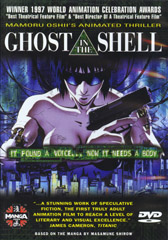 "Ghost in the Shell",
1995, Color, 1.85:1, Dolby Digital 5.1 English / Dolby Stereo Japanese, 1 Hr 22 min,
Unrated; Atsuko Tanaka / Mimi Woods, and Akio �tsuka / Richard George.
Directed by Mamoru Oshii. Screenplay by Kazunori Ti�.
"Ghost in the Shell",
1995, Color, 1.85:1, Dolby Digital 5.1 English / Dolby Stereo Japanese, 1 Hr 22 min,
Unrated; Atsuko Tanaka / Mimi Woods, and Akio �tsuka / Richard George.
Directed by Mamoru Oshii. Screenplay by Kazunori Ti�.
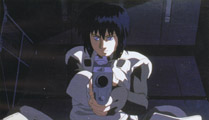 Non-sexual nudity, violence, and language
warning.
Non-sexual nudity, violence, and language
warning.
The year is 2029, and the world has become intensively information oriented. Advanced biochemistry has given birth to the augmentation and replacement of virtually any body part as well as all synthetic bodies. Everyone's mind is connected to the vast net and crime has developed into sophisticated hacking of the interactive network. The most notorious offender: the illusive entity known only as "the puppet master". Major Mokoto Kusanagi (a woman with a full cyborg body) and her team from Section 9 are on the case. When the puppet master turns out to be a secret government project with a mind of its own, the Major begins to question her own individuality as she separates ghost (her spirit) from the shell (the body).
 Ghost in the Shell is a very
sophisticated film with a polished story. Like so many good movies of the genre, it
was first a very successful comic series in Japan. The movie preserves much of the
original flavor but the lead character, Kusanagi, is drawn a little less 'cute' than in
the comic, giving her a more mature disposition. High production values are
evident throughout with some well cast voices in the English version, though some may find
the dialogue of the lead a little dry. I think this is intentional as it pushes the
cyborg image a little. The animated world has incredible detail not just
visually but
sonically as well, every nuance being rendered by the foley artists. There is some
nudity but it is totally non-sexual and comes off as rather tasteful (you have to see it
to fully understand). Weapons and violence are well researched and thus, rather
palpable.
Ghost in the Shell is a very
sophisticated film with a polished story. Like so many good movies of the genre, it
was first a very successful comic series in Japan. The movie preserves much of the
original flavor but the lead character, Kusanagi, is drawn a little less 'cute' than in
the comic, giving her a more mature disposition. High production values are
evident throughout with some well cast voices in the English version, though some may find
the dialogue of the lead a little dry. I think this is intentional as it pushes the
cyborg image a little. The animated world has incredible detail not just
visually but
sonically as well, every nuance being rendered by the foley artists. There is some
nudity but it is totally non-sexual and comes off as rather tasteful (you have to see it
to fully understand). Weapons and violence are well researched and thus, rather
palpable.
 Ghost in the Shell remains
one of my favorite films and rewards repeat viewing to fully explore it's many sub-themes.
Ghost in the Shell remains
one of my favorite films and rewards repeat viewing to fully explore it's many sub-themes.
Ghost in the Shell was one of the very first Anime films to be put to DVD and although the menus feel a little primitive, the video is quite good. The 16x9 enhanced transfer exhibits deep blacks, saturated colors, and fine detail, admirably preserving the visual art of this classic. Only on very close examination with a progressive display can you see evidence of edge enhancement yet the whole feature is somewhat soft in nature. The soundtrack has been remixed from the original Dolby Stereo to Dolby Digital 5.1 for the DVD, and although it is clean, the surrounds feel like they were input at the wrong level: They are dramatically too loud. There is also a feeling of 'over processed' ambiance. The included Japanese Dolby Stereo soundtrack is much more indicative of the original. Simply lowering your surrounds by 3dB each should bring things into balance, letting you enjoy a highly directionalised and dynamic soundfield.
Extras include a Making of feature and more.
![]()
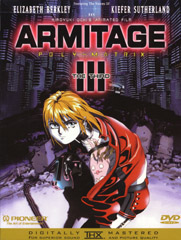 "Armitage III", 1994, Color, 2.0:1, Dolby Digital 5.1, 1 Hr 30 min, Unrated;
Elizabeth Berkley, and Kiefer Sutherland. Directed by Takuya Sato. Screenplay
by Chiaki Konaka.
"Armitage III", 1994, Color, 2.0:1, Dolby Digital 5.1, 1 Hr 30 min, Unrated;
Elizabeth Berkley, and Kiefer Sutherland. Directed by Takuya Sato. Screenplay
by Chiaki Konaka.
 Brief
nudity, violence, and language warning.
Brief
nudity, violence, and language warning.
Detective Ross Sylibus is transferred to a unit on a Martian colony and is assigned a very unorthodox partner named Naomi Armitage. There he finds that women are being murdered by the psychotic criminal D'anclaude. To stir things up more, every victim is found to be an illegally made third-generation android, built to be almost perfect replications of humans. It becomes a race against time when the government attempts to cover up the existence of the 'Third Types', and eliminate the only ones with the evidence. The answers lie in discovering why the Thirds were created to be so similar to humans, even to the extent of being indistinguishable from them on every level, mentally and biologically.
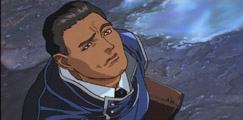 Armitage III employs a more traditional
Anime style which will likely strike American viewers as "cheep", reminding them
of some Saturday morning cartoons. But this film is not to be discounted as
such: there are many themes which run so deep that the bulk of viewers may miss the
finer points. The first reaction is to treat this as a rip-off of Blade Runner, but
there is more original content here for those with a more open mind. Originally done
as a 4 part series (available on VHS and LaserDisc) Armitage III the movie
splices existing material with a few new sequences to create the hour and a half
feature. While the story and its complexity are intact, the pacing is a little
erratic and may require a couple of viewings to fully appreciate it.
Armitage III employs a more traditional
Anime style which will likely strike American viewers as "cheep", reminding them
of some Saturday morning cartoons. But this film is not to be discounted as
such: there are many themes which run so deep that the bulk of viewers may miss the
finer points. The first reaction is to treat this as a rip-off of Blade Runner, but
there is more original content here for those with a more open mind. Originally done
as a 4 part series (available on VHS and LaserDisc) Armitage III the movie
splices existing material with a few new sequences to create the hour and a half
feature. While the story and its complexity are intact, the pacing is a little
erratic and may require a couple of viewings to fully appreciate it.
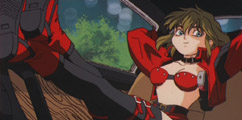 The THX certified DVD
demonstrates good video qualities but is not 16x9 enhanced. There is good shadow
detail and a freedom from edge enhancement but some compression artifacts are visible and
colors are not as smooth as they should be but they are consistent which suggests this is
an artistic choice rather than a mastering defect. The 5.1 Dolby Digital soundtrack
is highly active with aggressive use of all channels with at times highly directionalized
effects. Fidelity is slightly above par, but there is a feeling of over-processed
ambiance.
The THX certified DVD
demonstrates good video qualities but is not 16x9 enhanced. There is good shadow
detail and a freedom from edge enhancement but some compression artifacts are visible and
colors are not as smooth as they should be but they are consistent which suggests this is
an artistic choice rather than a mastering defect. The 5.1 Dolby Digital soundtrack
is highly active with aggressive use of all channels with at times highly directionalized
effects. Fidelity is slightly above par, but there is a feeling of over-processed
ambiance.
Extras include Production notes and Theatrical Trailer.
![]()
 "Princess Mononoke", 1997, Color, 1.85:1, Dolby Digital
5.1 English / Dolby Digital 5.1 Japanese, 2 Hr 30 min, Unrated; Y�ji Matsuda / Billy
Crudup, Yuriko Ishida / Claire Danes, Y�ko Tanaka / Minnie Driver,
Kaoru Kobayashi / Billy Bob Thornton, Akihiro Miwa / Gillian Anderson, and
Sumi Shimamoto / Jada Pinkett Smith. Directed by Hayao Miyazaki.
Screenplay by Hayao Miyazaki / Neil Gaiman.
"Princess Mononoke", 1997, Color, 1.85:1, Dolby Digital
5.1 English / Dolby Digital 5.1 Japanese, 2 Hr 30 min, Unrated; Y�ji Matsuda / Billy
Crudup, Yuriko Ishida / Claire Danes, Y�ko Tanaka / Minnie Driver,
Kaoru Kobayashi / Billy Bob Thornton, Akihiro Miwa / Gillian Anderson, and
Sumi Shimamoto / Jada Pinkett Smith. Directed by Hayao Miyazaki.
Screenplay by Hayao Miyazaki / Neil Gaiman.
 Violence warning.
Violence warning.
When a demon animal god stumbles into his village, prince Ashitaka receives an incurable cursed wound while killing the creature. He must travel as a rouge warrior to the distant lands from where the creature came in the hopes of finding a way to break the curse. His journey takes him to a land where he finds himself caught in a war between the animal gods of a great forest and an iron mining town that is exploiting it. The prince must bring peace to the land if he is ever to have a hope of being healed of his cursed wound.
 Princess Mononoke is a downright magical
movie with epic qualities (it's a full two and a half hours long). Miyazaki has
achieved a status of reverence in the international animation community and it is often
said that only animation can contain his incredible imagination. Indeed, it is
almost impossible to envision a movie like this being attempted in the conventional
medium. Princess Mononoke delivers wondrous locations, inspired characters, deep
themes, and a grand musical score. The attention to visual details is
breathtakingly strong. Elements such as the subtle lighting and shadows of a
forest, combined with real world camera effects bring the fictional world to life in a way
few animated features can.
Princess Mononoke is a downright magical
movie with epic qualities (it's a full two and a half hours long). Miyazaki has
achieved a status of reverence in the international animation community and it is often
said that only animation can contain his incredible imagination. Indeed, it is
almost impossible to envision a movie like this being attempted in the conventional
medium. Princess Mononoke delivers wondrous locations, inspired characters, deep
themes, and a grand musical score. The attention to visual details is
breathtakingly strong. Elements such as the subtle lighting and shadows of a
forest, combined with real world camera effects bring the fictional world to life in a way
few animated features can.
 Among its many subtext, the most prominent
is man's relationship with nature making the movie not only entertaining but very topical.
There are no clear cut 'bad' guys or 'good' guys and like much of Japanese
literature, strong spiritual elements are found throughout.
Among its many subtext, the most prominent
is man's relationship with nature making the movie not only entertaining but very topical.
There are no clear cut 'bad' guys or 'good' guys and like much of Japanese
literature, strong spiritual elements are found throughout.
Of course, it can't hurt to have some well known and talented Hollywood actors on board to do the English translation. Minnie Driver gives the Lady Iboshi character just the right aristocratic edge and Clair Danes feels almost type-cast as the fiery Princess. Billy Bob Thorton seems like an odd choice for the monk, but manages to fit right in, syncing with the rhythmic pace of his character's dialogue.
 The 16x9 enhanced video transfer has a nice slightly soft
feel to it with consistently saturated colors and good detail. Shadow delineation is
above average and digital artifacts for the most part are negligible, though some
compression is evident in large areas of flat color. The soundtrack is absolutely
breathtaking with a sweeping, spacious score, dynamic punchy effects, and robust bass
content. Fidelity scores above average while the surrounds engage aggressively but
never detracting attention away from the screen.
The 16x9 enhanced video transfer has a nice slightly soft
feel to it with consistently saturated colors and good detail. Shadow delineation is
above average and digital artifacts for the most part are negligible, though some
compression is evident in large areas of flat color. The soundtrack is absolutely
breathtaking with a sweeping, spacious score, dynamic punchy effects, and robust bass
content. Fidelity scores above average while the surrounds engage aggressively but
never detracting attention away from the screen.
Extras include a Making of feature and more.
![]()
 "Macross Plus (Vol. 1 & 2)" , 1994, Color, 1.33:1, Dolby Digital 5.1 English / Dolby Stereo
Japanese, 1 Hr 30 min, Unrated; Takumi Yamazaki / Lee Stone, Rika Fukami / Anne
Sherman, and Unisho Ishizuka / Richard George. Directed by Shoji
Kawamori. Original
screnplay by Shoji Kawamori.
"Macross Plus (Vol. 1 & 2)" , 1994, Color, 1.33:1, Dolby Digital 5.1 English / Dolby Stereo
Japanese, 1 Hr 30 min, Unrated; Takumi Yamazaki / Lee Stone, Rika Fukami / Anne
Sherman, and Unisho Ishizuka / Richard George. Directed by Shoji
Kawamori. Original
screnplay by Shoji Kawamori.
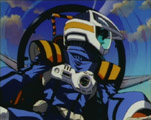 Mature, suggestive content and
language warning.
Mature, suggestive content and
language warning.
Part 1: Year 2040. The Ministry of Defense is
testing, by competition, two proposed prototypes for its next transforming attack-fighter.
Isamu Dyson is a hot-headed cocky jet fighter pilot assigned to one of the rival teams.
Competition heats up when he discovers that his old rival, Guld Bowman, is the test pilot
for opposite team. The arrival of Myung, a mutual ex-girlfriend, just adds more tension.
Part 2: Computer-generated pop star Sharon Apple has packed in another sell-out crowd for
her virtual reality concert. Myung is the manager of the production so Isamu attends
the show with a casual girlfriend from the flight team, and Yang who wants be the first
hacker to break into Sharon's programming. Something strange is suspected when
Sharon breaks the hack and gravitates towards Isamu. Strange anonymous phone calls
to the two pilots raises further suspicions. Back on the base, the rival flight
teams go at it in a frenzy of air combat maneuvers, ending in a catastrophe.

 Part 3: After
investigating the "accident" that left Isamu hospitalized, the UN Government in
charge of the test program unveils its hidden agenda: Scraping the program and going
with an unmanned 'ghost' fighter. Myung is torn between her feelings for the
two men, and admits that she's been providing the emotions for Sharon, the AI program being
incomplete. Isamu and Yang decide to steal their fighter and take out the ghost
fighter out of spite.
Part 3: After
investigating the "accident" that left Isamu hospitalized, the UN Government in
charge of the test program unveils its hidden agenda: Scraping the program and going
with an unmanned 'ghost' fighter. Myung is torn between her feelings for the
two men, and admits that she's been providing the emotions for Sharon, the AI program being
incomplete. Isamu and Yang decide to steal their fighter and take out the ghost
fighter out of spite.
Part 4: Isamu and Yang head toward Earth to get even with the pilot-less Ghost fighter and
Guld is sent to go after them in what turns out to be a spectacular final battle. In the
heat of the fight, Guld recalls events sealed in his memory and understands in an instant
why the three friends grew so distant. Meanwhile, in Macross City, Sharon Apple absorbs
Myung's thoughts and now has full control over the city, its citizens, and the ghost
fighter. Isamu must race to overcome the AI and save Myung.
 I need to point out that
Macross Plus is not 'Pan-and-Scan' per s�, despite its 4:3 aspect ratio. It's what
Anime fans call an OVA or OAV (Original Animation Video), a fancy way of saying it was
made for video release as oppose to cinema. This should not in anyway be
interpreted as a negative as Macross Plus holds up to some of the best movies out there.
I need to point out that
Macross Plus is not 'Pan-and-Scan' per s�, despite its 4:3 aspect ratio. It's what
Anime fans call an OVA or OAV (Original Animation Video), a fancy way of saying it was
made for video release as oppose to cinema. This should not in anyway be
interpreted as a negative as Macross Plus holds up to some of the best movies out there.
"Hard pressed will you be to find a better animation than Macross Plus" a friend once told me. I couldn't agree more.
 Macross Plus has a long
heritage. Decades ago it started as a Saturday morning cartoon in Japan. When
it was brought to North America in 1985, the original series did not have enough episodes
to meet the minimums for syndication. Macross was therefore spliced with two other
similar Anime series, the combination being known as Robotech, a space adventure whose
fiction revolves around fighter jets which transform into robots. Over the years
there have been many off-shoots including the more PG-13'ish "Macross II The
Movie" and Macross 7. A decade later, Macross Plus was created as a 4 part
series with every element from story, to artwork, to sound being as high caliber as any
animated feature ever made. Legions of Anime fans as well as newcomers to the genre
agree, Macross Plus is 'it'.
Macross Plus has a long
heritage. Decades ago it started as a Saturday morning cartoon in Japan. When
it was brought to North America in 1985, the original series did not have enough episodes
to meet the minimums for syndication. Macross was therefore spliced with two other
similar Anime series, the combination being known as Robotech, a space adventure whose
fiction revolves around fighter jets which transform into robots. Over the years
there have been many off-shoots including the more PG-13'ish "Macross II The
Movie" and Macross 7. A decade later, Macross Plus was created as a 4 part
series with every element from story, to artwork, to sound being as high caliber as any
animated feature ever made. Legions of Anime fans as well as newcomers to the genre
agree, Macross Plus is 'it'.
 Its hard to circumnavigate
the resemblance to the movie "Top Gun". Watch though, and you will be
amazed how this 'cartoon' does a far better job at developing its characters then the
Bruckhiemer film could. Another film Macross Plus borrows from is the Clint Eastwood
classic "FireFox", with its mind controlled fighter and climactic chase at the end.
Its hard to circumnavigate
the resemblance to the movie "Top Gun". Watch though, and you will be
amazed how this 'cartoon' does a far better job at developing its characters then the
Bruckhiemer film could. Another film Macross Plus borrows from is the Clint Eastwood
classic "FireFox", with its mind controlled fighter and climactic chase at the end.
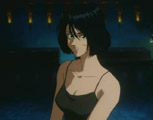 The visuals are absolutely
frenetic as the fighter planes twist and turn, change into robots and back again. It
is deliciously fast and furious. Animation permits the artists to put and move
cameras in ways that computers are only recently doing for real life. The English
dub is excellent, omitting the usual dryness and coming up with genuine personalities in
the voices
The visuals are absolutely
frenetic as the fighter planes twist and turn, change into robots and back again. It
is deliciously fast and furious. Animation permits the artists to put and move
cameras in ways that computers are only recently doing for real life. The English
dub is excellent, omitting the usual dryness and coming up with genuine personalities in
the voices
If you see only one piece of Anime, make it this one.
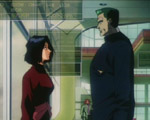 Alas, after all the
enthusiasm I have for this piece of work, I'm very sad to report that the DVD release is
decidedly poor.
Alas, after all the
enthusiasm I have for this piece of work, I'm very sad to report that the DVD release is
decidedly poor.
The video quality is reasonable with consistent colors and almost no signs of ugly edge enhancement though the occasional compression artifact is noted. It is on the soft side though and some rainbow artifacts suggest that it is simply an MPEG2 encoding of the master previously used for LaserDisc and VHS (which by the way were fantastic in their day). The most disappointing flaw is that they put the video frame inside of the DVD's picture area. My main video display has about 3% overscan, and when I first viewed the discs, I noticed some black space on the right side. When I brought them over to the PC to evaluate them on a progressive system, I confirmed they both have a black frame encoded around the image. Very bad form! Further, blacks are below set-up forcing you to raise your black level (brightness) a little bit.

 The audio on
the VHS release was the best soundtrack I had ever heard on tape and was what I would use
as my 'demo' material. The DVD release promised us a 5.1 remix which unfortunately
has been totally gaffed! The 5.1 soundtrack on the first pressings did not have a
center channel. The information was split to the main left and right channels, but
it was useless for anyone seated even slightly off center. A second pressing was
made which restored the center channel, but keeps the main left and right as they
originally were. In other words, the center channel information is in all three
front channels. All dialogue comes from all three speakers, making the
"fixed" soundtrack no better than the first. There is the original
Japanese Dolby Stereo soundtrack which can be watched with subtitles but here's another
idea: Against all instinct, I'm going to recommend you force your surround sound
processor to decode the English 5.1 soundtrack as Pro Logic. If it does not have the ability,
simply use the analogue left and right outputs from your DVD player and Pro Logic decode
that. The sound track will still be spacious with aggressive surround activity and
deep bass, while directional cues will actually be better as dialogue comes from where it
is supposed to (not all over the sound stage!).
The audio on
the VHS release was the best soundtrack I had ever heard on tape and was what I would use
as my 'demo' material. The DVD release promised us a 5.1 remix which unfortunately
has been totally gaffed! The 5.1 soundtrack on the first pressings did not have a
center channel. The information was split to the main left and right channels, but
it was useless for anyone seated even slightly off center. A second pressing was
made which restored the center channel, but keeps the main left and right as they
originally were. In other words, the center channel information is in all three
front channels. All dialogue comes from all three speakers, making the
"fixed" soundtrack no better than the first. There is the original
Japanese Dolby Stereo soundtrack which can be watched with subtitles but here's another
idea: Against all instinct, I'm going to recommend you force your surround sound
processor to decode the English 5.1 soundtrack as Pro Logic. If it does not have the ability,
simply use the analogue left and right outputs from your DVD player and Pro Logic decode
that. The sound track will still be spacious with aggressive surround activity and
deep bass, while directional cues will actually be better as dialogue comes from where it
is supposed to (not all over the sound stage!).
Shame on Manga for releasing a butchered DVD edition of this timeless Anime classic.
Extras include trailers and a stills gallery.
![]()
 "Ninja Scroll, 1995, Color, 1.33:1, Dolby Digital 5.1 English (Dolby Stereo
Japanese), 1 Hr 34 min, Unrated; Rudy Luzoion, Alfred Thor, Dean Elliot, and Maureen
O'Connell. Directed by Yoshiaki Kawajiri. Screenplay by Yoshiaki Kawajiri.
"Ninja Scroll, 1995, Color, 1.33:1, Dolby Digital 5.1 English (Dolby Stereo
Japanese), 1 Hr 34 min, Unrated; Rudy Luzoion, Alfred Thor, Dean Elliot, and Maureen
O'Connell. Directed by Yoshiaki Kawajiri. Screenplay by Yoshiaki Kawajiri.
 Graphic sex and extreme violence
warning.
Graphic sex and extreme violence
warning.
Jubei is a wandering swordsman who unwittingly falls into the path of evil when he saves the beautiful Ninja girl Kagero from one of 8 demons. An old adversary has been resurrected and is seeking to steal a great treasure from the Dark Shogun with which he will start an evil army to rule the land with fear and death. Jubei and Kagero must battle the demons in an all out blood bath.
As if the above warning was not enough, I'll say it again: this is a remarkably violent, gory piece of fiction which pushes what I can tolerate. I'm including it in this roundup to illustrate the diversity of the genre. Animation holds no barriers and the artists and authors unleash a very disturbing piece in Ninja Scroll. In some ways this is a shame as there is a pretty good story under all of it.
 Besides all the blood, Ninja Scroll
presents some nice visuals through cleaver animation. Its not as polished as some of
the more highly financed pieces but the action is an absolute frenzy of detailed moves.
The English dialogue unfortunately feels forced much of the time and on occasion distracts
as such.
Besides all the blood, Ninja Scroll
presents some nice visuals through cleaver animation. Its not as polished as some of
the more highly financed pieces but the action is an absolute frenzy of detailed moves.
The English dialogue unfortunately feels forced much of the time and on occasion distracts
as such.
 The video is reasonably
good. Some edge enhancement is noted but it is minor and does not distract.
Color feels played down while the entire presentation has a very soft feel, so much so
that detail feels sacrificed.
The video is reasonably
good. Some edge enhancement is noted but it is minor and does not distract.
Color feels played down while the entire presentation has a very soft feel, so much so
that detail feels sacrificed.
This is perhaps one of the more interesting 5.1 remixes you are likely to encounter. Originally released on video with an aggressive Dolby Stereo track, the sound artists really went to town with the discreet format: Unique sounds come from all around as the surrounds at times feel more used than the main channels. It is all very clear and intelligible with at times profound deep bass. The environments created are a little inconsistent as we move from a scene clearly given attention during the remix to others which feel neglected.
Extras include movie synopsis, character art and text, and the trailer.
![]()
 "Royal
Space Force - The Wings of Honneamise", 1985,
Color, 1.85:1, Dolby Digital 5.1 English (Dolby Stereo Japanese), 2 Hr 5 min, Unrated;
Robert Matthews, Melody Lee, and Lee Stone. Directed by Hiroyuki Yamaga. Screenplay by Hiroyuki Yamaga.
"Royal
Space Force - The Wings of Honneamise", 1985,
Color, 1.85:1, Dolby Digital 5.1 English (Dolby Stereo Japanese), 2 Hr 5 min, Unrated;
Robert Matthews, Melody Lee, and Lee Stone. Directed by Hiroyuki Yamaga. Screenplay by Hiroyuki Yamaga.
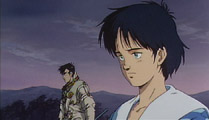 Mature
content and nudity warning.
Mature
content and nudity warning.
Set in a world similar to our own, mankind is on the brink of sending the first man into space. Having been shut out of the air force, Shiro Lhadatt signs up as a cadet in the Royal Space Force to fulfill his dream of flying. While the space program encounters ridicule and apathy from manipulative leaders and a cynical public, Shiro goes through personal growth when he becomes aquatinted with a deeply spiritual and moral girl, herself on an journey of self discovery. Despite military leaders conspiring to use the space program to spark an all-out war, Shiro and the team of aging scientists race against time to complete the first launch into space.
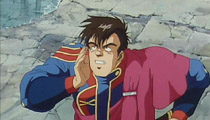 Wings of Honneamise is in many ways a significant milestone for Anime.
Hiroyuki Yamaga produced a 4 minute short film (included on the DVD) which he used to
pitch the concept to Bandai. They awarded him a budget of 8 Million dollars to
produce a full scale film, the largest budget for an animated feature at that time.
Perhaps more significant is that Wings was the first major piece of Anime with a totally
original story concept whereas most material up to that point was either adaptations of
comics or existing fiction.
Wings of Honneamise is in many ways a significant milestone for Anime.
Hiroyuki Yamaga produced a 4 minute short film (included on the DVD) which he used to
pitch the concept to Bandai. They awarded him a budget of 8 Million dollars to
produce a full scale film, the largest budget for an animated feature at that time.
Perhaps more significant is that Wings was the first major piece of Anime with a totally
original story concept whereas most material up to that point was either adaptations of
comics or existing fiction.
 Wings is interesting in that it has the least amount of action of all the
titles in our roundup. It is very story driven with dialogue sequences being the key
element. The space program is really just a backdrop on which to develop the
character of Shiro. The visual art is breathtaking. So detailed is the
fictional world that it is almost a character in and of itself. This detail does
come at a small sacrifice of smoothness, but it's worth it. The more complex a
character visually, be it lines on their face or folds in their clothes, the more
challenging it is to put those elements into motion. You could watch this film
several times and find new visual elements at every screening.
Wings is interesting in that it has the least amount of action of all the
titles in our roundup. It is very story driven with dialogue sequences being the key
element. The space program is really just a backdrop on which to develop the
character of Shiro. The visual art is breathtaking. So detailed is the
fictional world that it is almost a character in and of itself. This detail does
come at a small sacrifice of smoothness, but it's worth it. The more complex a
character visually, be it lines on their face or folds in their clothes, the more
challenging it is to put those elements into motion. You could watch this film
several times and find new visual elements at every screening.
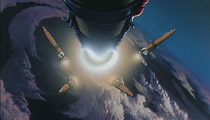 The transfer of this DVD is a perfect example of what a production facility
should never ever produce. Do not be lulled by the 16:9 enhancement, as any benefit
of an anamorphic transfer is ruined by the grotesque edge enhancement. I
hope I never again see a DVD with a more distracting and pronounced
implementation of
this total unnecessary artifact. The print used is in reasonable condition, though a
few scratches and other defects are noticeable but one can scarcely enjoy it for the edge
enhancement. It makes you wonder if anyone is even in the room during encoding, and
further, who ok's the master to be mass-replicated. Colors are consistent,
but shadow detail feels lacking.
The transfer of this DVD is a perfect example of what a production facility
should never ever produce. Do not be lulled by the 16:9 enhancement, as any benefit
of an anamorphic transfer is ruined by the grotesque edge enhancement. I
hope I never again see a DVD with a more distracting and pronounced
implementation of
this total unnecessary artifact. The print used is in reasonable condition, though a
few scratches and other defects are noticeable but one can scarcely enjoy it for the edge
enhancement. It makes you wonder if anyone is even in the room during encoding, and
further, who ok's the master to be mass-replicated. Colors are consistent,
but shadow detail feels lacking.
The audio is credited as being a 5.1 Dolby Digital remix but does not benefit from the discrete sound space. Music is spacious and open, but the soundtrack suffers the same defect as that of Macross Plus. Namely, center channel information is in all three front channels, yielding incorrect placement of sounds for anyone seated even just a little off center. In addition, there is a harsh quality and dialogue often distorts resulting in compromised intelligibility.
On the whole, this DVD is a tragedy for a piece of animation which deserved much, much better.
Extras include deleted scenes, the original 4 minute short story, directors commentary track, artwork, and more.
![]()
 "Akira", 1988,
Color, Dolby Digital 5.1 English (Dolby Stereo Japanese), 2 Hr 4 min, R;
Cam Clarke, Nozomu Sasaki. Directed by Katsuhiro Otomo. Writing credits:
Katsuhiro Otomo.
"Akira", 1988,
Color, Dolby Digital 5.1 English (Dolby Stereo Japanese), 2 Hr 4 min, R;
Cam Clarke, Nozomu Sasaki. Directed by Katsuhiro Otomo. Writing credits:
Katsuhiro Otomo.
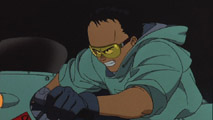 Violence and nudity warning.
Violence and nudity warning.
In a post apocalyptic neo Tokyo, childhood friends Kaneda and Tetsuo have grown into the reckless life of biker gangs. After stumbling across an escaped subject from a military research facility, the scientist become very interested in Tetsuo. The military later captures him for psychological experiments, unleashing dormant powers within. But when these powers come to the surface they break out of control as Testsuo lashes out at the world. Only Kaneda's friendship stand between him and total destruction.
Considered by many to be the quintessential
Anime feature film, Akira's DVD release of July 24th was well awaited.
For over a decade it has mesmerized fans of the genre but is not recommended
as a first exposure to Anime. Like Star Wars, Akira opens midway into a story
and ends in a similar, disconcerting
fashion.
 Those unfamiliar with the broad strokes
of the comic (manga) series on which Akira is based will find themselves at
a loss for what is going on. Nevertheless the remarkable visuals both at the films
release and still today make Akira worth the effort to watch.
Those unfamiliar with the broad strokes
of the comic (manga) series on which Akira is based will find themselves at
a loss for what is going on. Nevertheless the remarkable visuals both at the films
release and still today make Akira worth the effort to watch.
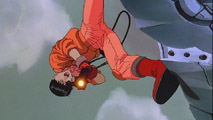 The
THX certified DVD presents an 16:9 enhanced image with deep color and
consistent detail. Mastered from a new interpositive from original
negative elements, some frowned upon edge enhancement is noted but it
rarely distracts and thus the visual restoration of this classic is on the
whole respectable.
The sound is dramatically better than most remember from the ubiquitous VHS
release. A delightfully quiet background brings out the remastering effort
which includes fresh music and even dialogue on the English dub.
But while the fidelity is high, the soundspace lacks an immersive quality and
often folds to one speaker or the other. Music is perhaps the
soundtrack's best quality.
The
THX certified DVD presents an 16:9 enhanced image with deep color and
consistent detail. Mastered from a new interpositive from original
negative elements, some frowned upon edge enhancement is noted but it
rarely distracts and thus the visual restoration of this classic is on the
whole respectable.
The sound is dramatically better than most remember from the ubiquitous VHS
release. A delightfully quiet background brings out the remastering effort
which includes fresh music and even dialogue on the English dub.
But while the fidelity is high, the soundspace lacks an immersive quality and
often folds to one speaker or the other. Music is perhaps the
soundtrack's best quality.
![]()
All images and titles � Their respective studios and distribution companies
� Copyright 2001 Secrets of Home Theater
& High Fidelity
Return to Table of Contents for this Issue.

